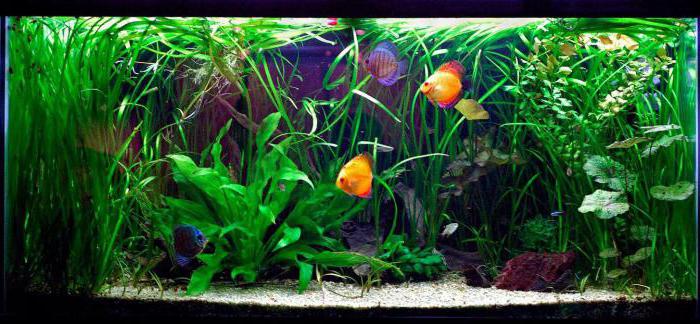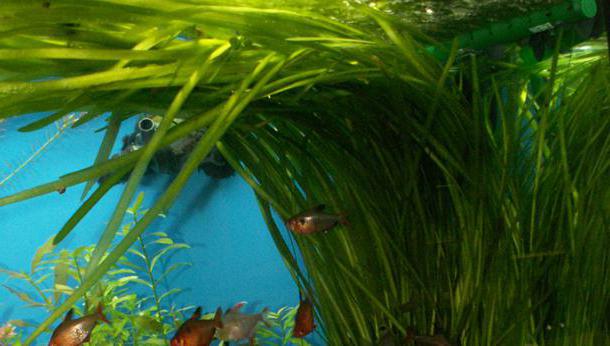Aquarium plant "vallisneria spiral": description, reproduction, maintenance and care
One of the most common plantsfamily vodkrasovyh considered vallisneria. The maintenance and care in the aquarium behind it is of interest to most people who are not indifferent to the creation of natural corners.
Vallisneria: where did it originate and where does it grow?
Despite the fact that the natural habitatit was originally a subtropical zone and hot tropics, today the plant is often found even in some water bodies of southern regions of Russia. In addition, adapted to the standing water of lakes and ponds, in rapid river flows, it also gets along well. Originality of the appearance of the vallisneria is given by bright green leaves.

Vallisneria spiral today is extremelyis popular among landscape designers. It is actively used to decorate artificial ponds or tall huge aquariums. Thanks to the unpretentiousness of the plant, it is even possible for novice amateur aquarium decorators to grow vallisneria.
Description of an underwater plant with spiral leaves
Most plants of this type areextremely fastidious: for them it is necessary to select a special primer, provide adequate lighting, maintain only a certain temperature of the water. Vallisneria spiral, on the contrary, is very unpretentious. Her bushes develop well on the sandy bottom of a dense fraction or among the stones pressing her roots under the water. Of course, light is needed for the plant primarily for timely and prolonged flowering. Therefore, in the natural environment, it blossoms only in the summer, and at home it is possible to achieve long-awaited flowers resembling white bells, even in the spring.
The peculiarity of the leaves of vallisneria is their rigidity.

Value of vallisneria in an aquarium or artificial pond
Supply of oxygen - the merit of the plant inexchange processes of the aquarium. Taking useful organic substances from the soil, creates all the conditions for the full existence of living organisms in the water namely vallisneria. The maintenance and care (the plant species are numerous, but several of them predominantly demand), performed in accordance with the requirements of cultivation, will allow the bushes to reproduce at an unprecedented rate. In this regard, vallisneria needs regular thinning of densely growing thickets.
It is extremely important to remember that sometimes in smallwater reservoirs or aquariums of insufficient height, the leaves of the plant create an almost impenetrable green veil, which prevents natural light transmission. The solution to this problem is one - to reduce the bushes of growing vallisneria.
What can do harm to underwater bushes?
It is possible to thin the plantation, but to shortenleaves can not be used under any circumstances. Living spider veinsneria will simply be doomed to perdition. After the cut, the leaves will turn yellow, rot and eventually disappear.

The presence of certain minerals in water canadversely affect its growth. For example, a saline solution used for the treatment of aquarium fish negatively affects the condition of the bushes: leaves become dull when used. Thus, not only this aquarium plant responds to salt.
Vallisneria spiral does not tolerate rust. Such a problem is not uncommon for many owners of ornamental aquariums in Russian cities. Using as a filler tap water, flowing through the iron rusting pipes, the hosts risk to destroy all the living things in the aquarium.
Food additives for fish
The presence of copper salts in water, which sometimesused in the manufacture of preparations against algae and slugs, also does not benefit vallisneria. And although manufacturers often refute the likelihood of adverse effects of drugs on aquarium vegetation, the reviews say the opposite. In particular, after the addition of "Bicillin-5" - a medicinal product for fish - Vallisneria spiral, giant die.
Giant Wallisnaires
This type of underwater plant is no less common among aquarists. The name predetermines the possibility of establishing such a vallisnerium only in the spacious high vessels of a home pond.

Reproduction of a plant
To propagate in a vegetative way a populara representative of aquarium flora at home, should create an optimal environment for her, close to the natural one. As a rule, the vallisneria grows a mustache, which subsequently form the daughter bushes. Separate from the mother plant young shoots can be after the formation of the daughter shoots several leaves and root lobes. Cutting a mustache, you can get a separate bush ready for independent existence.
Grow vallisneria seminal at homequite difficult. In addition, experts find this inappropriate, since the plant is dioecious. This means that each separate bush forms flowers of male and female sex.

Using a Wallisnierian Person
For domestic purposes, vallisneria is not used. However, biologists have repeatedly tried to identify additional benefits of an underwater plant that could be used in the farm. They managed to test spiral bushes in the process of sewage water treatment in urban centers. Moderately warm temperature drains would allow the vallisneria to grow and spread throughout the year.
In Russia, such studies wereconducted in one of the scientific institutions of the Perm region. Then the results of the experiments demonstrated that due to the presence of this representative of the water-colors, the content of harmful nitrogen and phosphorus salts became several times smaller. In this case, experiments were carried out only in sedimentation tanks with slow water flows.
Features of care and content spiral vallisneria
A frequent visitor in aquariums is a spiralvallisneria, brought from far abroad. The main supplier of the underwater species of the plant are the southern states of North America. Its characteristic difference can be called wider leaves, twisted as if into a tailspin.
The ideal temperature for thisa plant species is considered to be approximately +20 ... + 25 degrees. In a colder pond, her condition does not deteriorate, but there is a clear slowdown in growth. Periodic or partial change of water in the aquarium also positively affects the plant.
To create the most favorable living conditions in the Vallisneria artificial environment, the acidity and hardness of the water should ideally be neutral.

The lack of daylight helpsexcessive stretching of the leaves, after which they begin to lighten and turn yellow. Indoors, an aquarium with shrubs of such plants should be lit for at least 12 hours.
If the vallisneria spiral does not grow, the problemcan be hidden in the ground or in the state of the root system. Quite delicate roots of white color consist of small veins, hence it is convenient for them to grow in well-washed river sand. When creating the soil in the aquarium, it is necessary to remember about its preferred thickness - not less than 5 cm. In addition, underwater soil is important to feed at least the first time after planting, although if in the aquarium the standard density of planted fish is not needed in additional fertilizers.
In the home care of special difficulties does not causewelsh spiral. Diseases of the plant can be caused by a single cause - a low level of quality of tap water. When filling the aquarium, this fact needs to be taken into account, as owners often overlook such an important detail and begin to look for plant growth problems in lighting, water temperature and fish feed.

If you want to grow a real healthyVallisneria, which will become an element of decoration not only of the aquarium vessel, but of the whole house, it is not necessary to buy a new primer. When replacing the aquarium, the old soil from the previous vessel will come in handy: a lot of organic substances useful for plants usually accumulate on the bottom.
</ p>







